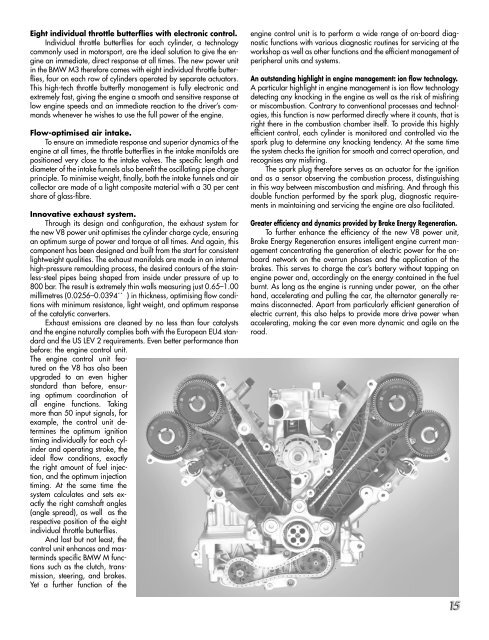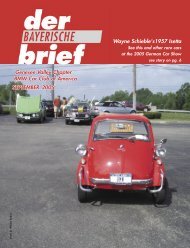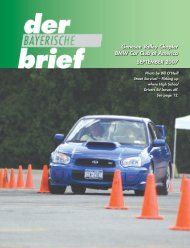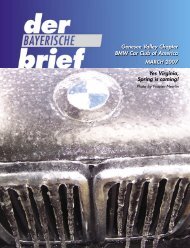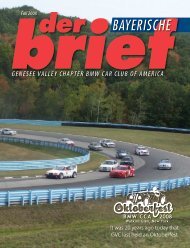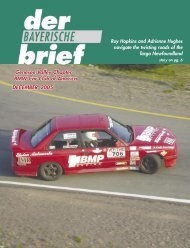Genesee Valley Chapter BMW Car Club of America JUNE 2007
Genesee Valley Chapter BMW Car Club of America JUNE 2007
Genesee Valley Chapter BMW Car Club of America JUNE 2007
Create successful ePaper yourself
Turn your PDF publications into a flip-book with our unique Google optimized e-Paper software.
Eight individual throttle butterfl ies with electronic control.<br />
Individual throttle butterfl ies for each cylinder, a technology<br />
commonly used in motorsport, are the ideal solution to give the engine<br />
an immediate, direct response at all times. The new power unit<br />
in the <strong>BMW</strong> M3 therefore comes with eight individual throttle butterfl<br />
ies, four on each row <strong>of</strong> cylinders operated by separate actuators.<br />
This high-tech throttle butterfl y management is fully electronic and<br />
extremely fast, giving the engine a smooth and sensitive response at<br />
low engine speeds and an immediate reaction to the driver’s commands<br />
whenever he wishes to use the full power <strong>of</strong> the engine.<br />
Flow-optimised air intake.<br />
To ensure an immediate response and superior dynamics <strong>of</strong> the<br />
engine at all times, the throttle butterfl ies in the intake manifolds are<br />
positioned very close to the intake valves. The specifi c length and<br />
diameter <strong>of</strong> the intake funnels also benefi t the oscillating pipe charge<br />
principle. To minimise weight, fi nally, both the intake funnels and air<br />
collector are made <strong>of</strong> a light composite material with a 30 per cent<br />
share <strong>of</strong> glass-fi bre.<br />
Innovative exhaust system.<br />
Through its design and confi guration, the exhaust system for<br />
the new V8 power unit optimises the cylinder charge cycle, ensuring<br />
an optimum surge <strong>of</strong> power and torque at all times. And again, this<br />
component has been designed and built from the start for consistent<br />
lightweight qualities. The exhaust manifolds are made in an internal<br />
high-pressure remoulding process, the desired contours <strong>of</strong> the stainless-steel<br />
pipes being shaped from inside under pressure <strong>of</strong> up to<br />
800 bar. The result is extremely thin walls measuring just 0.65–1.00<br />
millimetres (0.0256–0.0394´´ ) in thickness, optimising fl ow conditions<br />
with minimum resistance, light weight, and optimum response<br />
<strong>of</strong> the catalytic converters.<br />
Exhaust emissions are cleaned by no less than four catalysts<br />
and the engine naturally complies both with the European EU4 standard<br />
and the US LEV 2 requirements. Even better performance than<br />
before: the engine control unit.<br />
The engine control unit featured<br />
on the V8 has also been<br />
upgraded to an even higher<br />
standard than before, ensuring<br />
optimum coordination <strong>of</strong><br />
all engine functions. Taking<br />
more than 50 input signals, for<br />
example, the control unit determines<br />
the optimum ignition<br />
timing individually for each cylinder<br />
and operating stroke, the<br />
ideal fl ow conditions, exactly<br />
the right amount <strong>of</strong> fuel injection,<br />
and the optimum injection<br />
timing. At the same time the<br />
system calculates and sets exactly<br />
the right camshaft angles<br />
(angle spread), as well as the<br />
respective position <strong>of</strong> the eight<br />
individual throttle butterfl ies.<br />
And last but not least, the<br />
control unit enhances and masterminds<br />
specifi c <strong>BMW</strong> M functions<br />
such as the clutch, transmission,<br />
steering, and brakes.<br />
Yet a further function <strong>of</strong> the<br />
engine control unit is to perform a wide range <strong>of</strong> on-board diagnostic<br />
functions with various diagnostic routines for servicing at the<br />
workshop as well as other functions and the effi cient management <strong>of</strong><br />
peripheral units and systems.<br />
An outstanding highlight in engine management: ion fl ow technology.<br />
A particular highlight in engine management is ion fl ow technology<br />
detecting any knocking in the engine as well as the risk <strong>of</strong> misfi ring<br />
or miscombustion. Contrary to conventional processes and technologies,<br />
this function is now performed directly where it counts, that is<br />
right there in the combustion chamber itself. To provide this highly<br />
effi cient control, each cylinder is monitored and controlled via the<br />
spark plug to determine any knocking tendency. At the same time<br />
the system checks the ignition for smooth and correct operation, and<br />
recognises any misfi ring.<br />
The spark plug therefore serves as an actuator for the ignition<br />
and as a sensor observing the combustion process, distinguishing<br />
in this way between miscombustion and misfi ring. And through this<br />
double function performed by the spark plug, diagnostic requirements<br />
in maintaining and servicing the engine are also facilitated.<br />
Greater effi ciency and dynamics provided by Brake Energy Regeneration.<br />
To further enhance the effi ciency <strong>of</strong> the new V8 power unit,<br />
Brake Energy Regeneration ensures intelligent engine current management<br />
concentrating the generation <strong>of</strong> electric power for the onboard<br />
network on the overrun phases and the application <strong>of</strong> the<br />
brakes. This serves to charge the car’s battery without tapping on<br />
engine power and, accordingly on the energy contained in the fuel<br />
burnt. As long as the engine is running under power, on the other<br />
hand, accelerating and pulling the car, the alternator generally remains<br />
disconnected. Apart from particularly effi cient generation <strong>of</strong><br />
electric current, this also helps to provide more drive power when<br />
accelerating, making the car even more dynamic and agile on the<br />
road.<br />
15


